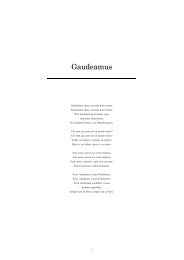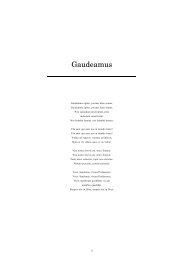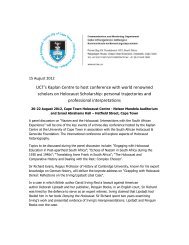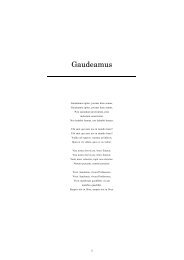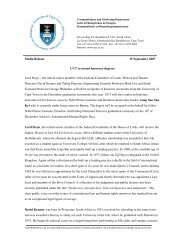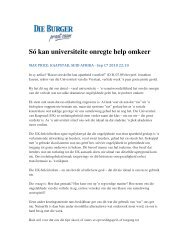uct heritage park management framework - University of Cape Town
uct heritage park management framework - University of Cape Town
uct heritage park management framework - University of Cape Town
Create successful ePaper yourself
Turn your PDF publications into a flip-book with our unique Google optimized e-Paper software.
43<br />
The role <strong>of</strong> screening shrubbery is to provide a dense screening shrubbery, 2 – 4 m in height, to<br />
break view lines into or from the site and hide unsightly elements in the landscape.<br />
Afromontane Forest<br />
Typical Afromontane forest describes an area with a closed canopy, created using species typical<br />
<strong>of</strong> the Peninsula forests, with low undergrowth. Smaller tree species create the forest margin and<br />
integrate with the adjoining planted landscape components.<br />
The role <strong>of</strong> this category is to create and maintain a pleasant shady environment, with open view<br />
lines through the trunks, for recreation, meditation or teaching nodes.<br />
The forest will form a strong green back drop to the campus and, with a canopy height <strong>of</strong> around<br />
10 m, serve a useful screening function <strong>of</strong> the campus from above.<br />
Shale Fynbos Parkland<br />
The <strong>park</strong>land comprises scattered small trees, creating an open <strong>park</strong>land feel, under-planted with<br />
grass or Low Shale Fynbos (see below) elements. Included are some areas or clumps <strong>of</strong> larger<br />
shrubs, planted to create barriers; break view lines and act as well-placed windbreaks.<br />
The <strong>park</strong>land role is to create a pleasant recreational area that is sufficiently open to provide a<br />
sense <strong>of</strong> security. The trees (height <strong>of</strong> 4 – 5 m – some up to 10 m eventually) will supply some<br />
screening and reinforce the green eyebrow <strong>of</strong> the forest.<br />
Short/low Shale Fynbos<br />
The low Fynbos element comprises small shrubs and geophytic herbs, forming a low planting<br />
suitable to be grown on the dam wall and the slopes below. The average height would be less<br />
than 1 m with some slightly taller species emerging from the low canopy.<br />
The vision here is to replace the existing Kikuyu green desert with locally endemic flora that will<br />
blend into the adjacent Shale Fynbos Parkland.<br />
Tall Shale Fynbos<br />
The taller Fynbos is proposed as a dense planting made up predominantly <strong>of</strong> small trees and large<br />
shrubs, endemic to the area.<br />
With a height <strong>of</strong> 4 – 5 m, the Fynbos will perform a strong screening role, while at the same time<br />
forming an attractive backdrop to the tennis court area. Some <strong>of</strong> the species will eventually reach<br />
closer to 10 m in height, connecting this with the Afromontane forest.<br />
Existing Pine “Eyebrows”<br />
This area presently consists <strong>of</strong> plantings <strong>of</strong> Stone Pines, other appropriate, non-invasive exotic<br />
species (e.g. Pin Oak) and some indigenous species that form the existing strong green “eyebrow”<br />
above the campus and below the tennis courts.<br />
The role <strong>of</strong> the planting would be to strengthen and maintain the iconic green backdrop to<br />
campus and perform a strong screening function: <strong>of</strong> the <strong>park</strong>ing and tennis courts from below and<br />
the campus from above.<br />
By maintaining the grass under-plantings a pleasant recreational space is created and this would<br />
be a perfect area to locate an amphitheatre under the existing pine canopy.<br />
Senescent trees need to be removed. All the gaps should be planted with Stone Pine to<br />
rejuvenate the pine wood.<br />
To help create a gate way from campus to the Heritage garden the line <strong>of</strong> the Pin Oak avenues<br />
planted on North and South lane should be continued up the sides <strong>of</strong> the stairs, using appropriate<br />
locally indigenous tree species such as Cunonia capensis and Nuxia floribunda.<br />
UCT Heritage Park Management Framework: Final Draft Report, July 2012





